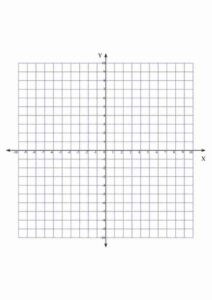Graph paper with numbers and its systematic grid of squares, has been a staple tool in various fields, from mathematics to engineering, art, and design. Its structured layout provides a visual aid that facilitates precise measurements, accurate plotting of data points, and the creation of intricate drawings. Among the diverse range of graph paper types available, the numbered template stands out as an essential tool for enhancing efficiency and accuracy in mathematical calculations, architectural designs, and scientific research.
Table of Contents
ToggleGraph Paper With Numbers Templates PDF:
Graph paper templates come in various configurations, with each type serving specific purposes. The numbered template, in particular, features a grid of squares where each intersection point is assigned a unique numerical value. These numbers serve as coordinates, allowing users to precisely locate points within the grid. The horizontal rows and vertical columns are labeled sequentially, providing a structured framework for organizing data and visualizing mathematical relationships.
Components of a Numbered Graph Paper Template Word:
- Grid Lines: The primary feature of graph paper is its grid of evenly spaced horizontal and vertical lines. These lines intersect at regular intervals, forming a series of squares or rectangles. The spacing between the lines can vary based on the template’s specifications, such as millimeter grids, centimeter grids, or custom spacing for specialized applications.
- Numerical Labels: Each intersection point where the grid lines meet is labeled with a numerical coordinate. The numbering typically follows a sequential order, such as integers or decimal values, depending on the level of precision required. For example, a standard Cartesian graph paper may use integers for whole units or decimal numbers for fractional units.
- Axis Labels: In addition to numerical coordinates, graph paper often includes axis labels to denote the horizontal (x-axis) and vertical (y-axis) scales. These labels provide context and orientation, allowing users to interpret the data accurately within the coordinate system.
- Title and Notes: Some graph paper templates feature sections for titles, notes, or annotations. These elements are useful for identifying the purpose of the graph, providing instructions, or including supplementary information related to the data or design being represented.
Applications of Numbered Graph Paper Templates:
The versatility of numbered graph paper makes it indispensable in various fields and tasks that require precision, organization, and visual representation. Below are some key applications where numbered graph paper templates play a crucial role:
1. Mathematical Graphing and Analysis
In mathematics, numbered graph paper is fundamental for plotting functions, graphing equations, and analyzing data sets. The numerical coordinates allow mathematicians, statisticians, and students to create accurate graphs that illustrate mathematical relationships, such as linear functions, quadratic equations, trigonometric curves, and scatter plots. By plotting points on the grid and connecting them, users can visualize patterns, trends, and mathematical models with clarity and precision.
2. Engineering and Drafting
Engineers, architects, and drafters rely on numbered graph paper for designing blueprints, technical drawings, and schematics. The grid structure helps maintain proportional scaling, aligning components accurately and ensuring geometric consistency. Whether sketching building plans, mechanical diagrams, electrical circuits, or computer-aided designs (CAD), the numbered grid serves as a guide for precise measurements, angles, and dimensions within the drawings.
3. Scientific Research and Data Visualization
In scientific research, numbered graph paper is used to chart experimental data, create scientific graphs, and analyze trends in research findings. From plotting data points in laboratory experiments to visualizing statistical distributions, graphs, and charts, the grid-based format enhances accuracy and readability. Scientists and researchers utilize numbered graph paper to present their results graphically, aiding in data interpretation, hypothesis testing, and conveying complex information effectively.
4. Educational Tools and Learning Resources
Educators incorporate numbered graph paper into lesson plans and educational materials to teach mathematical concepts, geometry, algebra, and data analysis. Students benefit from using graph paper templates to practice graphing functions, solving equations, exploring geometric shapes, and understanding coordinate geometry. The structured layout of numbered graph paper encourages systematic thinking, problem-solving skills, and mathematical fluency among learners of all ages.
5. Artistic and Design Applications
Beyond its mathematical and scientific uses, numbered graph paper inspires creativity in artistic endeavors and design projects. Artists, designers, and creative professionals leverage the grid format for sketching, doodling, drafting patterns, and creating intricate designs. Whether sketching architectural concepts, designing patterns for textiles, or plotting pixel art in digital media, numbered graph paper provides a structured canvas for precise composition and artistic expression.
Advantages of Using Graph Paper With Numbers Template:
The use of numbered graph paper templates offers several advantages that contribute to enhanced productivity, accuracy, and clarity in various tasks and disciplines:
- Precision: The numerical coordinates on graph paper enable precise plotting of points, measurements, and geometric figures, ensuring accuracy in calculations and designs.
- Organization: The grid layout facilitates systematic organization of data, making it easier to interpret graphs, charts, and diagrams without confusion.
- Visualization: Graph paper aids in visualizing mathematical concepts, data relationships, and spatial arrangements, fostering better understanding and analysis.
- Consistency: The structured grid promotes consistency in scaling, proportions, and alignment, essential for technical drawings, engineering diagrams, and architectural plans.
- Efficiency: By providing a ready-made framework, numbered graph paper streamlines the process of graphing, plotting, and designing, saving time and effort for users.
Conclusion
In conclusion, numbered graph paper templates are invaluable tools that promote precision, efficiency, and creativity across diverse disciplines. Whether used for mathematical calculations, engineering designs, scientific research, educational purposes, or artistic endeavors, the structured grid and numerical coordinates offer a reliable framework for visual representation and data analysis. By leveraging the benefits of numbered graph paper, professionals, students, and enthusiasts alike can enhance their work, foster clearer communication, and achieve greater accuracy in their endeavors.
![Free Printable Graph Paper Online [PDF Download] ✅ ❤️](https://igraphpaper.com/wordpress/wp-content/uploads/2024/04/igraphpaper-logo.png)




